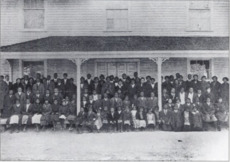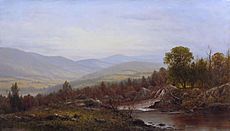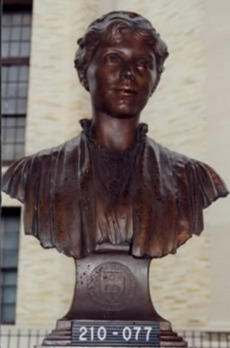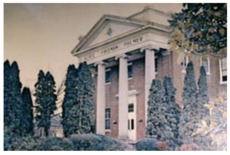Alice Freeman Palmer facts for kids
Quick facts for kids
Alice Elvira Freeman Palmer
|
|
|---|---|

Alice Freeman Palmer, 1881-1887,
Wellesley College |
|
| Born |
Alice Elvira Freeman
February 21, 1855 |
| Died | December 6, 1902 (aged 47) Paris, France
|
| Resting place | Houghton Chapel, Wellesley College, Wellesley, MA |
| Education |
|
| Occupation |
|
| Spouse(s) |
George Herbert Palmer
(m. 1887; |
| Parent(s) | James Warren Freeman Elizabeth Josephine Higley |
Alice Freeman Palmer (born February 21, 1855 – died December 6, 1902) was an important American educator. She was known for helping women get a college education.
As Alice Freeman, she became the President of Wellesley College from 1881 to 1887. She was very young when she took on this big role. Later, she married George Herbert Palmer, a professor at Harvard. From 1892 to 1895, she also served as the Dean of Women at the new University of Chicago.
Alice Freeman Palmer strongly believed that women should go to college. She worked hard to create more opportunities for them. She helped improve how colleges prepared women for studies. She also gave public talks and supported many education groups. She was a co-founder and president of the Association of Collegiate Alumnae. This group later became the American Association of University Women. She was honored for her work by being inducted into the Hall of Fame for Great Americans.
She believed that a college education was like "life insurance" for women. It would give them the skills they needed to support themselves if necessary. Many saw her as a model of the "New Woman" of the 19th century. This term described independent and educated women.
Contents
Early Life and Education
Growing Up in New York
Alice Elvira Freeman was born on February 21, 1855, in Colesville, New York. She was the oldest of four children. Her parents were Elizabeth Josephine Higley and James Warren Freeman. Alice was very close to her mother. Her mother was only 17 when Alice was born. They shared many duties caring for the younger children and the home.
Alice's mother supported children's rights, women's rights, and health care. She also supported the temperance movement. Her father was a farmer who loved education and science. He shared these interests with Alice. Both parents came from early families in the Susquehanna Valley of southern New York.
A Young Learner
Alice taught herself to read at age three. She loved reading aloud throughout her life. In 1861, her father went to Albany Medical College to become a doctor. This meant her mother had to manage the farm alone. During this time, Alice went to a small country school.
When Alice was six, her family moved to Windsor, New York. Her father started his medical practice there. At age ten, she began attending Windsor Academy. This school allowed both boys and girls to study together.
Alice was a very eager and ambitious student. She wanted to gain knowledge and build a strong character. She won awards for her writing and speeches. She was inspired by a speaker named Anna Elizabeth Dickinson. Alice also helped her community. She even gave some of her college savings to others when she didn't have a winter coat herself.
Dreaming of College
Alice was determined to go to college. She later said that a college education was "life insurance for a girl." It would help her provide for herself if needed. Her parents could only afford to send one child, a son, to college. So, they agreed to help Alice if she promised to support her brother and other siblings.
Higher Education Journey
University of Michigan

In 1870, the University of Michigan started accepting women. Alice took the entrance exam in 1872. The university was the largest in the country at that time. She impressed the university president, James B. Angell. She was accepted but had to catch up on some subjects. She quickly completed these before her second year.
In 1873, her father lost his farm and belongings in a bad investment. He asked Alice to come home. But Alice, with help from her professors, found a teaching job. She taught Greek and Latin in Ottawa, Illinois. This allowed her to continue her studies as a junior. From then on, she supported herself.
Alice became the top student in her class. She gave a speech at her graduation in 1876.
Career and Leadership
Early Teaching Roles
After graduating, Alice taught at a private boarding school in Geneva, Wisconsin. In 1877, she became the principal of a high school in East Saginaw, Michigan. Her father declared bankruptcy that year. Alice took on his debts and moved her family to Saginaw. She paid for their rented house with her salary. Her father eventually built a successful medical practice there. Alice worked very hard and faced some health challenges during this time.
Leading Wellesley College
Henry Fowle Durant, who founded Wellesley College, offered Alice a teaching job three times. First in math, then Greek, and finally history. She accepted the history professorship in 1879.
In October 1881, she was named acting president of Wellesley. When Durant passed away, Alice, at only 26 years old, was chosen as the college president. She was the first woman to lead a well-known college in the nation.
Alice greatly improved Wellesley's academic programs. She raised the standards for students to get into the school. She also set up 15 "feeder schools" to help students prepare for college. She hired many excellent teachers. She worked to change the idea that education would harm a woman's femininity or health. She showed that educated women could be strong and successful.
She created a "cottage system" where teachers and students lived together in small homes. She was very involved with students and staff. Those closest to her affectionately called her "The Princess." During her time as president, she faced health issues and was advised to rest. She retired from Wellesley in June 1887.
The University of Michigan gave her an honorary Ph.D. in 1882. Columbia University gave her an honorary L.H.D. in 1887.
A Champion for Women's Education
Alice Freeman Palmer was a pioneer in promoting college education for women. She became a national figure. She was seen as a "New Woman" – a respected, financially independent, and successful academic woman. She was dedicated to advancing women's education. She appeared in magazines and newspapers and was often asked to give speeches. After leaving Wellesley, she also wrote articles for major magazines.
She worked hard to create more opportunities for college women. She chose leaders and scholars who could create even more chances for others.
In 1881, Palmer helped start the Association of Collegiate Alumnae. This group later became the American Association of University Women. She served as its President from 1885 to 1887, and again from 1889 to 1890.
After her marriage, she continued to lecture about higher education for women. She was appointed to the Massachusetts Board of Education. Palmer was a trustee for many organizations and worked to solve educational problems. She once resigned from a college's board when a young woman was denied admission because she was Black. The school changed its policy soon after Palmer resigned. In 1893, she helped organize the Woman's Building for the World's Fair in Chicago.
She received honorary Doctor of Laws degrees from Union College and the University of Wisconsin–Madison in 1895. She was a member of the Massachusetts State Board of Education from 1889 to 1902. She also led the Woman's Education Association in Boston. She held important roles in other groups that supported scientific research by women and education for girls in Spain.
Dean at the University of Chicago
In 1892, Alice accepted a position at the new University of Chicago. She became the non-resident dean of the women's department. Her husband was also offered a job there, but he chose to stay at Harvard.
She was required to be on campus for one-third of the school year. Her job was to help female students plan their studies and connect with the university. During her time as dean, the percentage of female students at the school doubled. It went from 24% to 48%. This growth caused some disagreement among mainly male faculty members. Feeling discouraged by their reaction, she resigned in 1895.
Personal Life

Alice had many admirers during college and her early career. She waited to marry until she was settled and had a good income. Some people also liked that she remained an independent, unmarried woman, as she was seen as a model of the "New Woman."
While at Wellesley, she met George Herbert Palmer, a professor at Harvard University. They became engaged. She resigned from Wellesley in June 1887, partly due to her health challenges. She was advised to rest and recover. Her future husband also felt she had already made great improvements at the university.
Alice and George married on December 23, 1887. She then began giving public speeches on higher education for women. They had a marriage based on partnership and friendship. They both pursued their careers. George helped manage their home, especially when Alice was working at the University of Chicago.
During summers at her husband's home in Boxford, Massachusetts, she enjoyed exploring, sewing, birdwatching, and photography. They took long trips to Europe during George's sabbaticals. They lived in their favorite cities and explored the countryside by bicycle. Alice wrote many beautiful poems. Some are found in books about her life and marriage. In 1901, she wrote the hymn How sweet and silent is the place.
In December 1902, while the Palmers were in Paris, Alice experienced severe pain. She had surgery for a bowel obstruction.
Death and Legacy
Alice died of a heart attack while recovering from surgery. A service was held at Harvard University in 1903 to honor her life. Many college presidents and important educators attended.
George Herbert Palmer kept her ashes until 1909. That year, a monument was built by sculptor Daniel Chester French at Houghton Chapel in Wellesley College. In 1933, George's ashes were placed next to his wife's, as he had wished.
Posthumous Honors

The Alice Freeman Palmer Institute, also known as the Palmer Memorial Institute, was founded in Sedalia, North Carolina. It was started in 1902 by Charlotte Hawkins Brown for African-American students. Palmer had sponsored Brown's education and mentored her. Brown met Palmer shortly before her death while raising money for the school. The school was named after Palmer following her death. In 1922, the school built the Alice Freeman Building. It had an auditorium, library, classrooms, and offices. It was the first known school for African-Americans in the South to have a collection of art reproductions. Sadly, it was destroyed in a fire in 1971.
In 1908, the first special fund at the AAUW was created in Palmer's memory. This fund helps women attend colleges, do research, and write dissertations.
In 1920, Alice Freeman Palmer was chosen for the Hall of Fame for Great Americans.
In 1921, Whittier College named a new women's literary society after her. Students researched and worked hard to name the group after Alice Freeman Palmer. They admired her strong support for women's higher education in the late 1800s. Today, the Palmer Society still aims to help women achieve their highest ideals.
In World War II, the United States liberty ship SS Alice F. Palmer was named in her honor.






